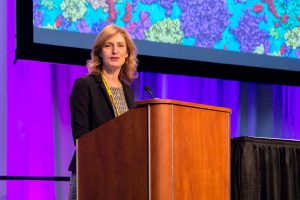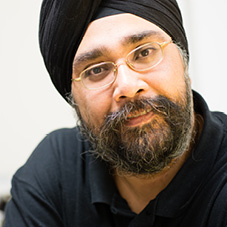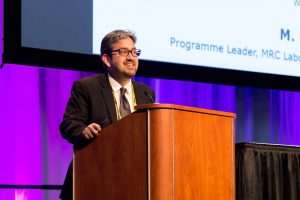GigaScience at ASCB|EMBO 2019 Meeting, Washington DC
The Walter E. Washington Convention Center in Washington DC was the venue for this year’s ASCB|EMBO 2019 Meeting that took place on 7-11 December 2019. The American Society of Cell Biology conference, now merged with the EMBO meeting, is the largest yearly gathering for the cell imaging community, and GigaScience has attended in the past. In the 2017 meeting participating in a panel on sharing and reusing cell imaging data, and Laurie’s slides on the GigaScience experience can be seen here. This year GigaScience Data Scientist Chris Armit was there and reports on how our knowledge of Cell Biology is revolutionising our understanding of living systems.
Google Maps of the Cell: integrating metabolomics, lipidomics, proteomics, and imaging data
A major theme of this conference was how microscopy is transforming our knowledge of the cell. In the symposium entitled “Google Maps of the Cell”, Daniel Colón-Ramos of Yale University provided evidence in support of the existence of the glycolytic metabolon. Biochemistry was formed on the understanding of fermentation and glycolysis and, as Daniel explained, biochemists argued about the existence of an organelle known as the glycolytic metabolon in the 1970s. This hypothetical organelle was used to explain the faster than expected rates of metabolism in living cells when compared to cell-free extracts, and a salient feature of the glycolytic metabolon hypothesis was the co-localisation of glycolytic proteins that would enable rapid glycolysis in an ‘assembly line’ fashion. When first proposed, this hypothesis was considered controversial, as the tools were not available to investigate the existence of this organelle. However, by using C. elegans as a model, Daniel was able to show that hypoxia stimulates localisation of glycolytic proteins, such as phosphofructokinase, to synapses of the C. elegans nervous system. Glycolytic proteins are known to be necessary for the synaptic vesicle cycle, synaptic function and behaviour. These imaging data demonstrate that glycolytic proteins dynamically localise to synapses, and support the existence of the glycolytic metabolon in the synapse of the nematode worm. It is anticipated that these observations will be followed up in other model organism species.

Elena Ikonen highlighted the importance of the membrane protein Seipin in lipid droplet generation. Photo credit: Courtesy ASCB
This was followed by an insightful and thought-provoking talk from Elena Ikonen of the University of Helsinki on the role of Seipin, a membrane protein thought to be important in lipid trafficking. CRISPR/Cas9 was used to knockout Seipin in human A431 cells, and these cells showed no obvious phenotype when Elena’s group employed the standard lipidomic approach of assessing overall abundance of various lipid species in the cell. To more accurately assess the role of Seipin, Elena’s lab used the auxin-inducible degron system to deplete Seipin in cultured cells. As with the CRISPR/Cas9 knockout studies, there was no observed change in lipid levels. However, a striking change in morphology was observed, with lipid droplet size visibly diminishing in Seipin-depleted cells. This highlights a role of Seipin in lipid droplet generation, whereby Seipin facilitates triglyceride flow to lipid droplets, and thereby assists in the formation of large lipid droplets that serve as an important energy source. These findings have broad implications for next-gen lipidomics, and highlight the need for morphological inspection of lipid droplet size to complement the existing method of measuring the abundance of various lipid species in the cell.

Paola Picotti detailed protein structural changes in yeast cells exposed to osmotic shock. Photo credit: Courtesy ASCB
On a related theme, Paola Picotti of ETH, Zurich – who along with M. Madan Babu was awarded the EMBO Gold Medal at ASCB|EMBO 2019 – presented a recently developed in situ structural proteomics method, known as LiP-MS, that utilises mass spectrometry ‘fingerprints’ to identify structural states of a given protein. Paola applied this method to the analysis of osmotic stress in the yeast S. cerevisiae, and used functional enrichment analysis to compare protein abundance changes and structural changes. This approach was highly informative, and uncovered multiple biological processes that were correlated with protein structural change, but not protein abundance. In summary, these talks highlighted the importance of combining imaging with proteomic, lipidomic, and metabolomics studies that focus on abundance (see our integrative metabolomics series for examples of this type of work).
Evolutionary Cell Biology of the Nucleus

Harmit Malik explained how predator-prey models help us understand how proteins are recruited to the centromere. Photo credit: Courtesy ASCB
When we use the term ‘evolution’, one tends to think of a very slow process of change that occurs over geological time. However, in the field of host and viral evolution, evolution is thought of as a highly rapid process. In the symposium “What Blueprints Tell Us: How genomics informs cell biology”, Harmit Malik of the Fred Hutchinson Cancer Research Center/HHMI explains that, in predator-prey relationships “arms race drives rapid evolution”. Harmit applies this predator-prey modelling approach to explain innovation in protein-coding genes, and highlights a critical role of centromere association. As an illustrative example, Harmit refers to two genes in Drosophila known as HP1B and Umbrea. HP1B is not essential, and the HP1B protein is localised to heterochromatin. In contrast, Umbrea, which is thought to be a recently evolved gene that is related to HP1B, is essential. So how do evolutionary young genes become essential? Unlike HP1B protein, Umbrea protein is localised to the centromere, the central portion of a chromosome that links a pair of sister chromatids. During mitosis, spindle fibers attach to the centromere to ensure mitotic fidelity. The centromere has an essential function in mitosis, and Harmit speculates that Umbrea may have become an essential gene by virtue of a specific role of the Umbrea protein at the centromere. Is this phenomenon specific to Umbrea? In his talk, Harmit reported on the centromeric histone gene, Cid, “which has undergone at least four independent gene duplications during Drosophila evolution”. Chromosome defects are evident in heterozygous Cid-mutant Drosophila cells, and Harmit speculates that missing mouthparts in Cid mutant fruitflies may be suggestive of a general lack of viable nuclei due to inherent defects in mitotic fidelity. An important point was that Harmit was able to rescue the Cid-mutant phenotype by addition of only a small amount of wild-type Cid protein. The surprising take-home message here is that, despite their essential role in chromosome segregation, centromeric histones tend to evolve quite rapidly. If these findings were followed up in mammalian cells, they may have important ramifications for our understanding of abnormal mitotic spindle formation and failure to segregate nuclei mitotically in human disease.

M. Madan Babu explained how fusion events affect post-translational modification sites. Photo credit: Courtesy ASCB
Evolutionary novelty was also a theme of M. Madan Babu’s talk. M. Madan Babu explained that fusion products in cancer escape post-translational modification, and that many of these post-translational modification sites may provide evolutionary novelty. Key to understanding this process is what Madan refers to as proteomic intrinsically disordered regions (IDRs) that do not adopt defined tertiary structures. The plasticity observed in these protein regions enables novel functionality to be a feature of the disordered proteome. Madan additionally presented IDR-Screen, which is a discovery platform that utilises machine learning to identify functional disordered regions in proteins and learn what makes them functional.
Machine Learning and Morphology
The ASCB|EMBO Meeting prides itself on using computational modelling and biophysics to “Build the Cell from the Ground Up”. A salient example of this was the work presented by Assaf Zaritsky of the Ben-Gurion University of the Negev, Israel. In the minisymposium entitled “New Perspectives in Cell Biology – Frontiers of the Cell”, Assaf – who has published live time-lapse data of in vitro wound healing experiments in GigaScience – showcased an image analysis pipeline that was used to identify between metastatic and non-metastatic cells in phase-contrast time-lapse image data of melanoma cell lines. The core concept here is to identify single cells and track them over time, and to use a machine learning approach to quantitatively describe the morphology of the melanoma cells. Assaf explained that only one of the 56 quantitative descriptors that he used in this study could identify between metastatic and non-metastatic cells. The challenge then became identifying the morphological phenotype that was captured using this quantitative descriptor. Through manual assessment of the phase-contrast image data, it was retrospectively observed that cellular protrusions in melanoma cells are a subtle phenotype that can be identified by computational methods and that correlate with metastatic cells. This study illustrates the utility of the machine learning approach when applied to very large image datasets. Watch this space for some upcoming announcements in this area from us.
Displacing centrosomes using FLUCS
Jeff Woodruff of UT Southwestern Medical Center, Dallas showcased a fantastic use case of FLUCS microscopy in our understanding of pericentriolar material assembly and disassembly. FLUCS microscopy is a method that allows researchers to manipulate flow in cells and tissues. Jeff’s lab have used this technology to apply a “tuneable force” to the C. elegans embryos. This allows researchers to create flow patterns in the direction that they want, and to observe the effect that this has on living cells. In the C. elegans embryo, Jeff observed that FLUCS can only displace centrosomes prior to anaphase. As Jeff explains, “during spindle assembly the pericentriolar material is very strong and does not fracture.” In contrast, entry into anaphase weakens the pericentriolar material (PCM) scaffold, which coincides with it becoming brittle, a phenomenon associated with depletion of Polo kinase. This highly novel approach offers an important experimental system for exerting force on living cells to see how they respond.
GFP25: Lighting up Cell Biology
Jennifer Lippincott-Schwartz presented “GFP25: Lighting up Cell Biology”, an absorbing seminar that celebrated the 25th anniversary of Martin Chalfie’s first paper on the use of Green Fluorescent Protein (GFP). The celebrations included the “ASCB Green Fluorescent Protein Image and Video Contest” and delegates were all provided with bright green glow-in-the-dark bracelets for the occasion. Jennifer highlighted some of the key figures in the early GFP work, including Doug Prasher, who first cloned GFP, and Martin Chalfie, who first expressed GFP transgenically in prokaryotic (E. coli) and eukaryotic (C. elegans) cells. There was additional acknowledgement of the earlier work of Osamu Shimomura, who first purified GFP in 1962, and the outstanding achievements of the chemist Roger Tsien, who optimised GFP to produce brighter and different coloured fluorescent proteins. Osamu Shimomura, Martin Chalfie and Roger Tsien were awarded the Nobel Prize in Chemistry in 2008 “for the discovery and development of the green fluorescent protein, GFP”.
Using GFP, Jennifer Lippincott-Schwartz uncovered a hitherto unexpected retrograde pathway by which Golgi proteins are translocated from the ER to the Golgi apparatus. This recycling system is pivotal in our understanding of protein transport and the maintenance of Golgi apparatus in the cell. Furthermore, through recruiting Eric Betzig and Harald Hess, Jennifer played an invaluable role in enabling these physicists to develop Photo-Activated Localization Microscope (PALM) (see recent GigaBlog Seeing is Believing). Eric Betzig, Stefan W. Hell, and William E. Moerner were awarded the Nobel Prize in Chemistry in 2014 “for the development of super-resolved fluorescence microscopy”.
Jennifer wishes to use Correlative Light and Electron Microscopy (CLEM) techniques, such as Focused ion beam SEM (FIB-SEM), to more accurately define the organelle interactome (see recent GigaBlog Seeing is Believing), and highlighted the need to understand tethering proteins and how all of these interactions are coordinated within the cell. This was an exceptional tribute to the work that has been accomplished since GFP was first used in expression studies.
One Hundred Years of Gratitude: D’Arcy Thompson at 100

Jennifer Zallen highlighted the role of the cell surface receptor Tartan at compartment boundaries. Photo credit: Courtesy ASCB
The last symposium of the conference was dedicated to the great Scottish biologist D’Arcy Wentworth Thompson, whose seminal book “On Growth and Form”, first published 100 years ago, has inspired generations of biologists seeking to understand patterning and morphogenesis in living systems. Jennifer Zallen of HHMI/Sloan Kettering Institute, New York presented the astonishing work her lab has accomplished in decoding tissue morphogenesis in Drosophila embryogenesis. It has often been noted that animals are very fond of stripes, and the Drosophila embryo is a salient example of this whereby gap genes and pair rule genes are known to compartmentalise the Drosophila body axis in a series of stripes along the anterior-posterior (AP) axis. Jennifer explained that to convert the stripe patterns into spatial cues, the Drosophila embryo utilises receptors of the Toll family. Cells in the AP axis express one, two, or three of the receptors Toll-2, Toll-6, or Toll-8, and if you remove two or three of these receptors, patterning problems along the AP axis quickly become apparent. These observations highlight a critical role of Toll receptors in positional identity, and Jennifer posits a “positional Toll receptor code” that directs axis elongation in Drosophila. Axis elongation itself utilises cell rearrangement via the planar cell polarity (PCP) pathway, however Jennifer highlighted the importance of compartment boundaries in the rearrangement process. Two critical intermediates in this process are the Ten-m and Tartan proteins. Jennifer showed that the Ten-m single-pass transmembrane protein is present throughout the embryo, but is mobilised to act locally at compartment boundaries by the cell surface receptor Tartan. Tartan is specifically required at these compartment boundaries, and recruits Ten-m to the borders of Tartan, which is expressed in a stripy pattern. These stripy borders become enriched in Myosin II, which locally regulates mechanical tension thus changes the shape of the Drosophila embryo so that it elongates.

Carl-Philipp Heisenberg explored the role of tissue rigidity transitions in morphogenesis. Photo credit: Courtesy ASCB
On a related note, Carl-Philipp Heisenberg of the Institute of Science and Technology, Austria, explored collective cell migration in the gastrulating zebrafish embryo. Traditionally, it was thought that cell adhesion was primarily responsible for cell sorting during gastrulation. However, Carl-Philipp argues that mechanical forces are at play at this critical step in embryogenesis, and highlights the role of tissue rigidity transitions in this process. The core concept here is that ‘floppiness’ or fluidity is an emergent property of a giant cluster of cells that is not observed in a small cluster of cells. Carl-Philipp convincingly showed that there is a sharp transition in the rigidity of tissue – a critical point – at which the viscosity drops and the tissue morphology changes. This is a highly insightful finding and may explain the rapidity of the observed morphogenetic changes that are observed during zebrafish gastrulation. Carl-Philipp further argues that cell connectivity is a universal parameter that can be used to explain differences in fluidity in different tissue types. This is a bold hypothesis, and one wonders whether tissue rigidity could be used to explain the rapid morphological changes associated with other zebrafish embryonic morphogenetic processes such as neural tube formation, and pectoral fin bud elongation.
This was an utterly inspiring meeting and one that would make D’Arcy Wentworth Thompson very proud.
The next ASCB|EMBO Meeting will be in Philadelphia on December 5th-9th 2020.
